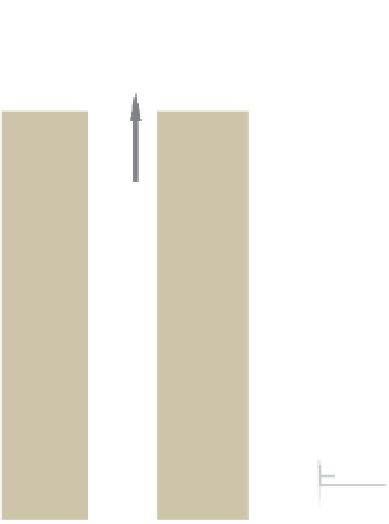Geoscience Reference
In-Depth Information
coincident with cross-overs in both the U- and
V-components, gives the downhole position of the plane
of the conductor, and the symmetry of all three compon-
ents indicates that it is oriented perpendicular to the local
direction of the drillhole trajectory. The combination of the
uniquely locates the eddy current system relative to the
drillhole. Modelling of the data with a current
filament
model showed that an east-dipping, north-northeast
trending conductor fitted the survey data (
Fig. 5.95a
).
Drilling based on this interpretation intersected
a)
b)
Ni (%)
0.0
2.0
4.0
6.0
8.0
Disseminated
sulphides
60
Massive to
semi-massive
sulphides
70
Receiver
(Rx)
Conductivity
log
80
Network
& disseminated
sulphides
90
Induced
eddy
currents
Transmitter
(Tx)
'
mineralisation. Both the multi-loop axial and single-loop
cross-component DHEM surveys demonstrate that this
zone of mineralisation does not extend north of drillhole
SH20.
'
zone 4
100
Thin massive
sulphide lenses
in disseminated
sulphides & waste
110
Depth
(m)
Ni assay
Figure 5.96
Downhole induction logging. (a) Schematic illustration
of a downhole induction logging tool. (b) Correlation between an
inductive conductivity log and Ni assays of drillcore. Data are from
the Enonkoski Ni sulphide mine in Eastern Finland. Host rocks are
ma
5.8.4
Induction logging
Induction logging is a form of downhole frequency domain
EM surveying (see
Section 5.7.1.1
)
which measures the
electrical conductivity of the rocks forming the walls of
the drillhole. Like all EM methods, it is most effective for
logging conductive zones rather than resistivity contrasts
within resistive zones, although the logs generally correlate
closely with electrical resistivity logs (see
Section 5.6.8
)
.
Inductive methods can be used in dry and plastic-cased
drillholes; this is a distinct advantage over electrical
methods which require water in the drillhole for electrical
connection to the wall rocks.
The logging tool contains transmitter and receiver coils
oriented co-axially with the tool
c and ultrama
relate to the electrical properties of the rock volume within
about a 1 m radius of the drillhole.
Inductive conductivity logs are interpreted in much the
same way as electrical resistivity logs (see
Section 5.6.8
)
.
One particular application is assisting in grade control
measurements of massive nickel sulphide deposits. As
illustrated in
Fig. 5.96b
, there can be strong correlations
between nickel content and electrical conductivity allowing
ore-grade to be rapidly and economically assessed with
induction logging.
is long axis, which is coin-
cident with the drillhole axis (
Fig. 5.96a
)
. In its basic form
the transmitter coil, which carries alternating current at
typically 200 Hz to 40 kHz, induces eddy currents in the
surrounding rock that, for homogeneous rocks, flow con-
centrically around the drillhole. The circulating current
'
5.9
Airborne electromagnetic surveying
Like all airborne geophysical methods, airborne electro-
magnetic (AEM) surveying offers the ability to survey large
areas quickly and economically, but with lower resolution
and less penetration than ground-based EM surveys. AEM
systems were originally developed in the frequency domain
(FD-AEM) to detect conductive massive sulphide bodies
within the resistive rocks of the Precambrian shield of
Canada. The subsequent need to explore for other types
of targets and explore other kinds of geological environ-
ments combined with developments in EM systems has led
to higher-sensitivity time domain (TD-AEM) systems now
being used almost exclusively for mineral exploration and
geological mapping. In particular, TD-AEM systems have
flow is restricted in its along-hole extent, i.e. the current
distribution approximates a disc centred on the probe. This
determines the along-hole resolution of the data, typically
about 10 cm. The magnetic
fields associated with the eddy
currents induce an alternating secondary voltage in the
receiver coil and its phase-lag (see
Section 5.7.1.1
), with
respect to the primary signal, is used to infer conductivity
of the drillhole environment. Penetration into the wall
rocks increases with increasing transmitter
-
receiver coil
separation, and is also strongly in
uenced by the frequency
of the transmitted current and the conductivity of the wall
rocks, i.e. skin-effects (see
Section 5.2.3.1
). Data typically














































Search WWH ::

Custom Search